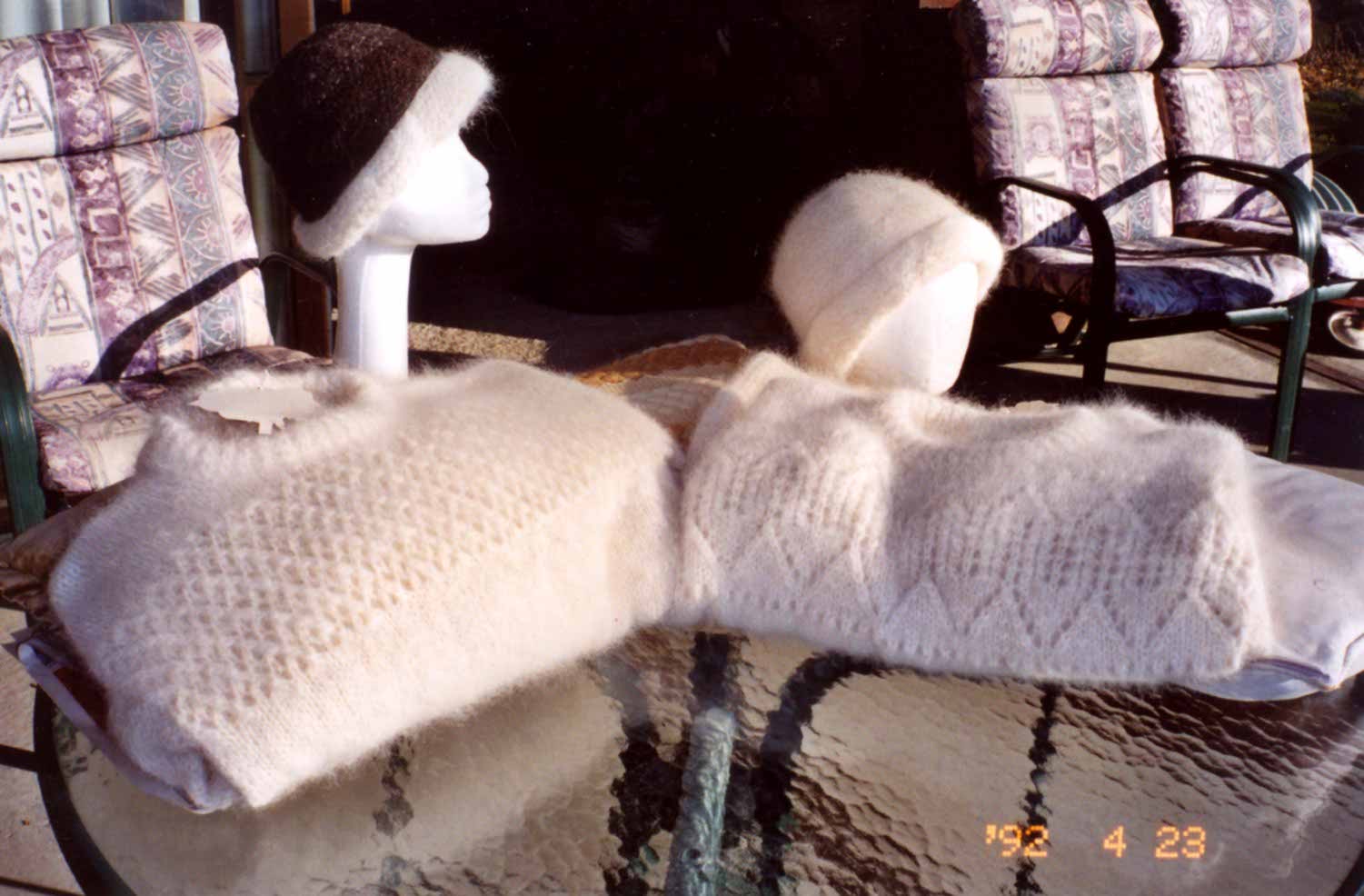For the betterment of the breed.

The Samoyed is an ancient breed originating from Russia and much admired for its beautiful white coat, smiling face, happy disposition and general good health.
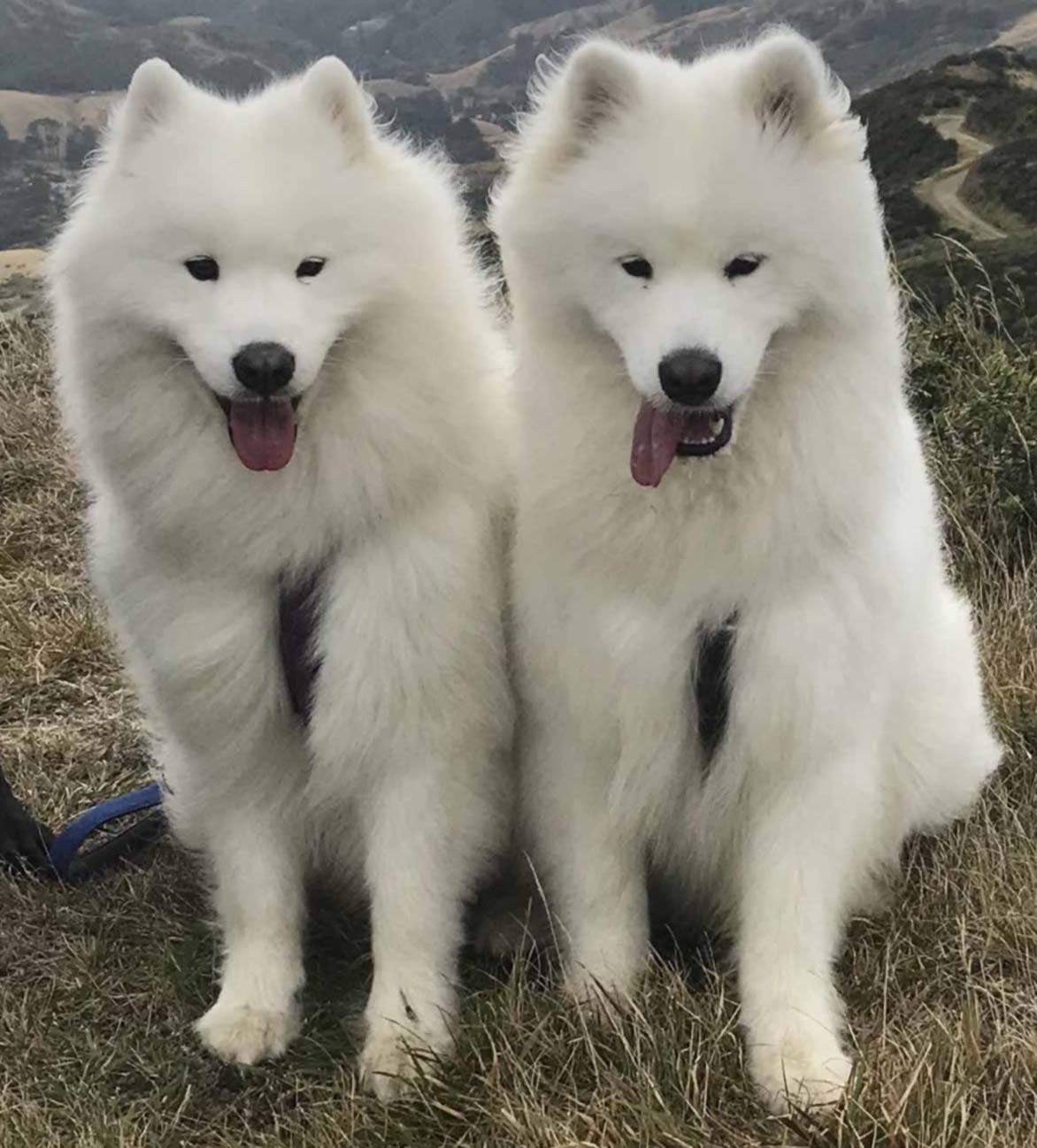
SPINNING SAMOYED HAIR
The undercoat of the Samoyed is a beautiful fibre to work with but requires the strength of wool with barbs on the strands to ensure the garment holds together properly. Wool from the Perendale sheep is a popular choice.
“The Hair Of The Dog” by Sandra Stewart
Lisa Chapman spinning Samoyed hair
(Ask Lisa Chapman / Tess Weir for an article and photos.)
The Hair Of The Dog
by Sandra Stewart, Skrownek Samoyed Stud (Reprinted from 1993 Samoyed supplement). New Zealand Kennel Club Gazette May 2006 Samoyed Supplement. Pages 8 and 9.
The Samoyed coat has long been labelled the breed's crowning glory. And certainly there is nothing quite so breathtaking as a beautifully groomed biscuit or white Sammie in full coat. For the groomer and bather too it's undoubtedly been somewhat of a breathtaking task for there's no escaping reparing this breed for the show ring takes time and effort.
However nothing quite matches a Sam in full feathers and a ring full of immaculately prepared dogs is a magnificent sight.
The first 1909 Samoyed standard allowed the parti-coloured dog.
"Black and white, brown and white, as well as pure white and white with slight lemon markings" were the first words on colour. A study of the early dogs reveals both black like Mrs Cammack's Pedro, and the "deep biscuit" - read dark brown - Sabarka, were used at stud.
It was not until 1920, when the second standard was adopted in England, that the parti-coloured dog was excluded and the "pure white, white and biscuit, and cream" became the standard colours for the breed.
Probably then too the debate on colour began. And still continues off and on today.
The public, most judges and some breeders prefer the pure white. So breed pure whites and penalise colour?
But there's the rub. For undoubtedly the better-textured coat is one with some colour in it, or on a dog with colour in parents or close ancestry. The breed standard wants the harsh-textured, stand-offish, weather resistant outer coat and dense woolly undercoat.
But how often these days do we see a Sammie coat collapse and part, showing the skin, when a bit of drizzle falls? Too often I contend.
Dominion Samoyed Club patron and president Elma Todd of Tilenka Samoyeds in Christchurch has been a long-time fan of the coloured coat, breeding particularly for it in the litter which produced one of the New Zealand most biscuit Samoyeds, Ch Marusja Arova of Tilenka.
The very white coat certainly seemed to be the soft one in her kennels, more often than not on a dog with lighter pigment and sometimes lighter eye colour, she says.
"I remember trying to show Pumpkin (Ch Marusja). She was peaches and cream, a lovely overall apricot colour with deeper tinges on her ears. I remember arriving at a show and being told to take her home and wash it out. It was a disqualification I was told."
People even questioned whether she was a Samoyed or not.
"There were gasps all round the ring - but she didn't look back.
"She had tremendous coat texture and, just as well, because you couldn't dry clean her. She had to be bathed before each show.
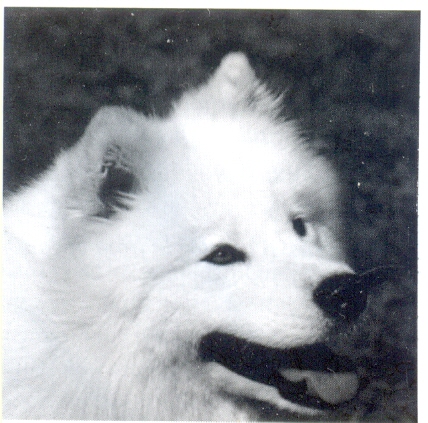
"If you bathed a white dog the day before a show, the coat would flop all over the place. Bath Pumpkin the day before and you'd still have a stand-off coat.
"She had beautiful pigment and her eyes were a lovely rich brown. She had a dense black lip line, black roof to her mouth, the only part of the mouth with any pink was the pink line just above her teeth. And
her tongue of course. She had black toenails and magnificent foot feathers - the whole picture was one of rich colour."
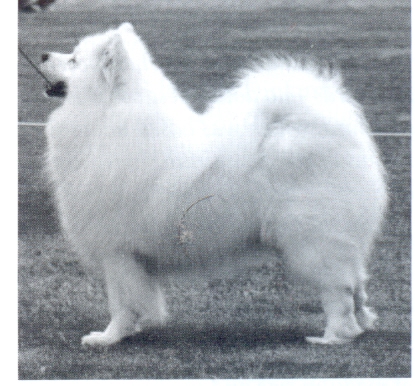
Elma Todd laments the fact that more coloured dogs are not in the show ring. But it's still the case that judges penalise it, she says.
"I've heard a lot of different opinions. The late Claude Naylor said colour in the Samoyed was only all right if evenly distributed through the coat. Patches weren't allowed.
"I don't know where people get this from. There's certainly nothing written about it and the original Sams were a patched multi-coloured lot. Perhaps people are just confusing it with other breed standards."
Another stunning coloured Samoyed bitch was the late Eng Ch Fairvilla Anastasia, owned by Betty Moody of Novaskaya Kennels. One of the few Samoyeds registered as "biscuit", Ana won her first CC at 7 months and her last, with BOB, at 11 years of age. She also took Best in Show at the Samoyed Owners and Breeders League Show at 14 1/2 years of age. A deep orange-apricot with lighter shaded tail and trousers, this bitch was literally a show stopper, reputedly halting the class at Crufts while her owner discussed her colour with spectators.
While the coloured coat may have its detractors in the show ring, with Samoyed fibre garments, the delicate shading of coloured coat certainly comes into its own. It's easier to spin as well.
Helen Roberts of North Canterbury, a keen fibre spinner, had her introduction to the breed through her two coloured Sammie girls. While she rates herself as an enthusiastic amateur, several Canterbury spinners have won Quality Mark certificates and national spinning prizes with Samoyed fibre and wool garments.
"I started when Freya was a pup - that's 25 years ago",' she said. "I couldn't get anyone to spin it, so I thought I'd do it myself. It was trial and error to start with. And then 1 joined the Spinners and Weavers' Guild. When all else fails - read the instructions".
Helen's first effort resulted in a gorgeous jersey -lovely to look at but not practical to wear.
"I wanted a Samoyed jersey but didn't realise how it would fluff up and shed with washing. It still has novelty value and is a great talking point. But it's much better to have something you can wear."
The jersey was spun on a mill-spun single thread, with the Samoyed fibre plied onto the thread, giving a very high Sammie fibre content.
"When you shake it bits fly everywhere. It's like a jolly snowstorm". Helen now uses one-ply wool and one-ply Samoyed or better still, had blends at around 75 per cent wool, 25 per cent dog. A little bit of silk added luxury and a tad of Angora added softness and made the garment that bit different, she says.
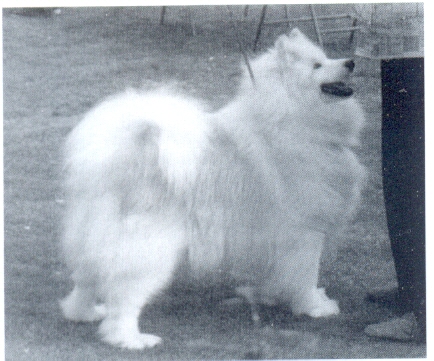
Samoyed fibre needs wool. The fibre does not have the scales which hold a thread of wool together and the 75:25 mix gives a wearable garment. Plus it doesn't shed with washing.
You collect the soft undercoat from the adult Samoyed, a puppy coat is too short. You don't have to card it as collecting it by combing the soft undercoat out of the dog, the fibre has already effectively been carded.
Helen spins the fibre "straight from the dog". She also finds fibre from bitches easier to spin than from males and the texture of the biscuit-coloured coats making for easier spinning.
Once spun and plied, you tie the fibre into hanks and wash it, Helen says.
"You wash it in really hot water going from really hot to really cold to shock and pre-shrink it."
"It takes an awful lot of courage to dump those hanks you've worked so hard over straight into hot water".
But that's what you do. Wash with pure Sunlight soap to take the grease out. Don't agitate it too much or you're likely to felt it.
Then hang it on the line to dry on a nice breezy day. Ball it up and it's ready to knit up.
The fibre will dye nicely and Helen has seen a magnificent multi coloured woven jacket of blended wool and Samoyed fibre.
The insulating properties of Sammie fibre are well known. Several World War 2 airmen shot down into water owe their lives to the insulating properties of a Samoyed jersey.
Helen Roberts is an innovative spinner, her spinning portfolio full of interesting fibre threads.
There's a bit of Corgi, Finnish Spitz, an Alaskan Malamute/Siberian Husky mix, Elkhound, a goat, rabbit and a malamute thread, Birman cat, Pekingese, Shetland sheepdog, Belgian Shepherd and
Newfoundland.
She's a fan of lacy open pattern due to the big needles when knitting the Sammie fibre up.
"Keep air in the pattern, don't do a fisherman's rib or stocking stitch - it's just too hot.
"And be careful with the garment. Treat it like wool and remember the time and effort that's gone in to making it and treat it accordingly. Be careful too of rings, jewellery and dog claws catching on it."
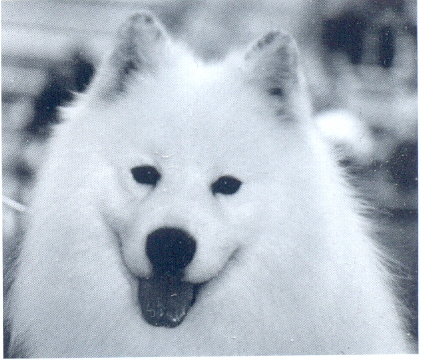
Oh yes, a word of warning! Dogs find a fibre jersey fascinating.
"I've had some very near misses," Helen says. "Almost christened by one male. Now I know what a bitch in season feels like.
"Dogs certainly know you're wearing some relation. So be careful and don't leave the garment around where your Sams can get to it", she says.
New Zealand Kennel Club Supplement May 2006.
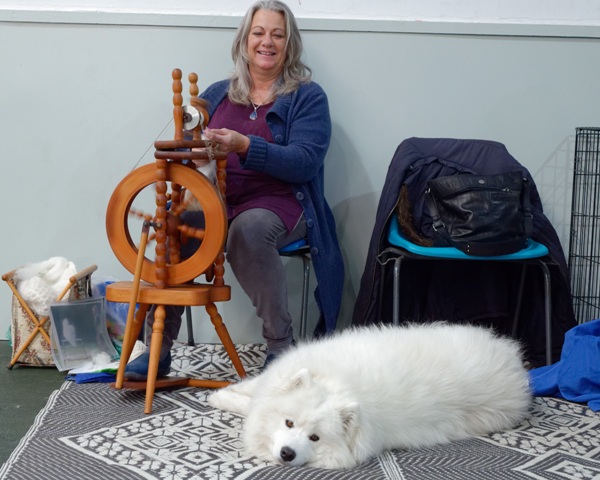
Lisa Chapman and Phoebe spinning Samoyed hair at the Championship Show 1 July 2016. Photo by Mark Hickman. Printed in the Sleigh Courier 2016 Summer magazine.
